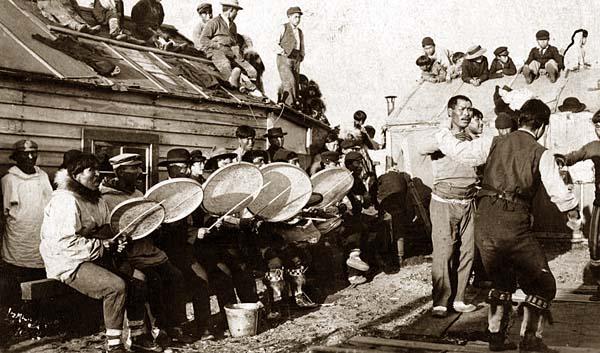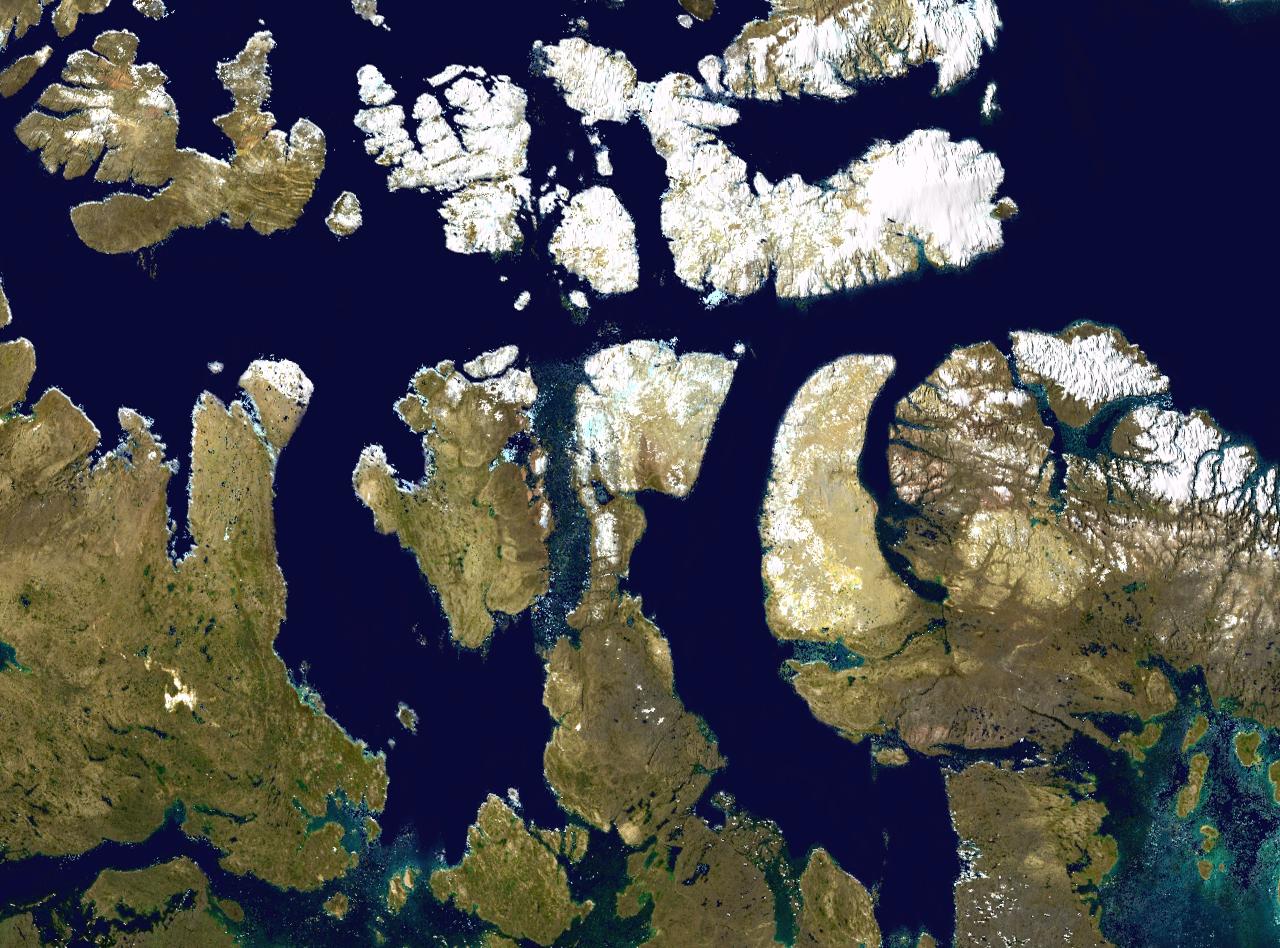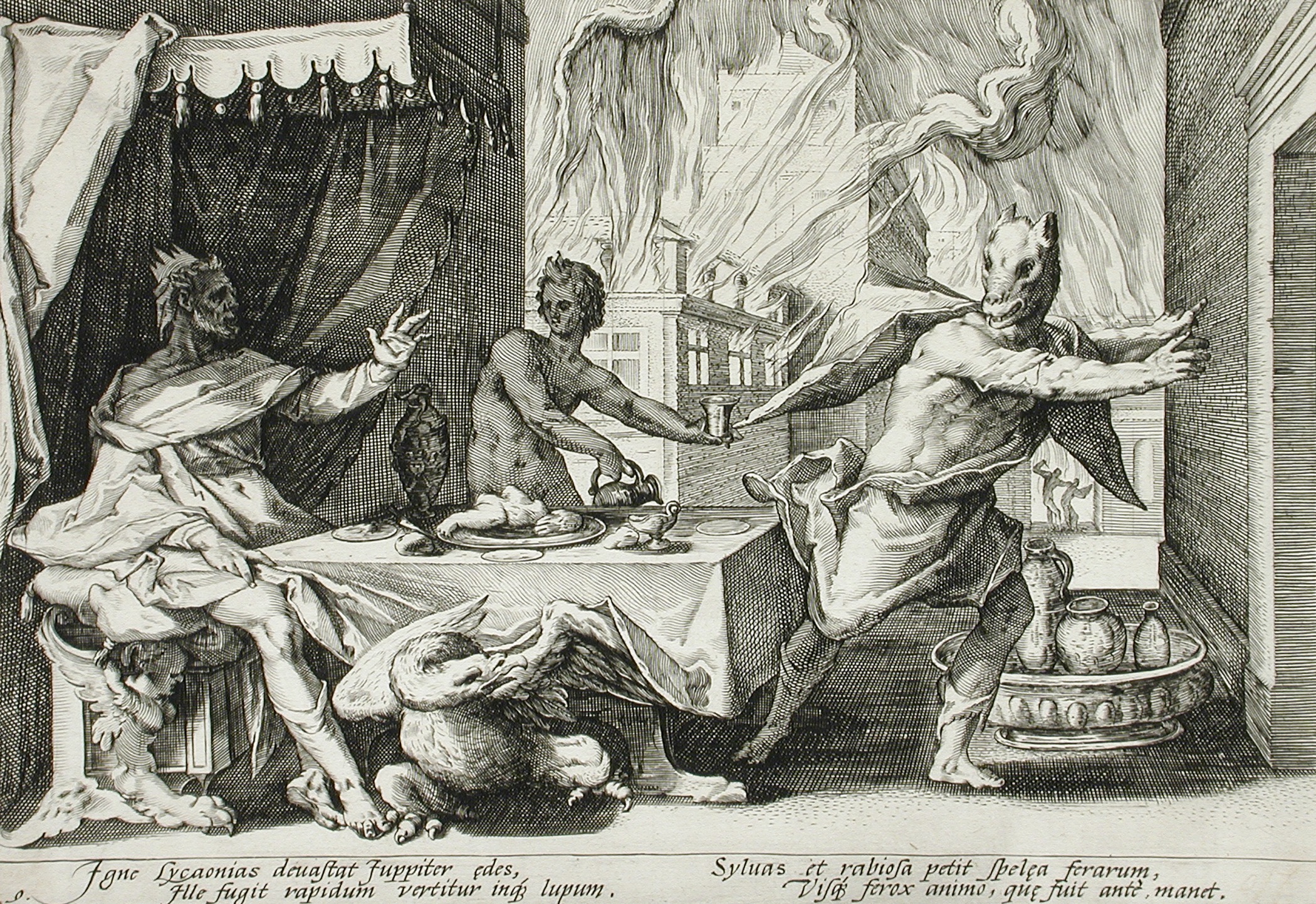|
Ijiraq
In the Inuit religion, an ijiraq ( or ) is a shapeshifting creature said to kidnap children, hide them away and abandon them. The inuksuk (or inukshuk) of stone allow these children to find their way back if they can convince the ijiraq to let them go. Description In North Baffin dialects ''ijiraq'' means Shape Shifter. While '' Tariaksuq'' appear like a half-man-half-caribou monster, an ijiraq can appear in any form it chooses, making it particularly deceptive. Their eyes will always stay red, no matter what they shapeshift into. Their real form is just like a human, but their eyes and mouth are sideways. ''(The book of Dutch writer Floortje Zwigtman says only the shaman knows the real form of the Ijiraq).'' When you are hunting somewhere that Ijirait (plural) inhabit, you will see them in the corner of your eye for a fleeting moment (like tariaksuq, shadow people) ''(following another reference, you see a strange caribou in the corner of your eye instead of a normal shadow'' ... [...More Info...] [...Related Items...] OR: [Wikipedia] [Google] [Baidu] |
Tariaksuq
In Inuit mythology the Tariaksuq (Taqriaqsuk, Taqriaqsuq, Tarriaksuk, Tarriaksuq, Tarriassuk, Tarriassuq; (plural) "Shadow-People", Taqriaqsuit, Tariaksuit, Tarriaksuit, Tarriassuit) is a humanoid creature associated with Shadow, shadows, invisibility and obscurity. It is said that, for the most part, they are the same as any other human being. They have houses, families, weapons, tools, and more. Where they deviate from normal people, however, is that they are not visible by looking straight at them. In looking directly at them, they either disappear into the separate world which they occupy, apart from our own, or they are only seen for the shadow they cast. They only become visible if they are killed, and they are said to appear as half-man-half-caribou creatures. Aside from the strange condition of their visibility, it is also known that they can only catch prey while hunting it on foot. See also * Ijiraq (mythology) References {{Inuit religion Inuit legendary creat ... [...More Info...] [...Related Items...] OR: [Wikipedia] [Google] [Baidu] |
Inuit Religion
Inuit religion is the shared spiritual beliefs and practices of the Inuit, an indigenous people from Alaska, northern Canada, Greenland, and parts of Siberia. Their religion shares many similarities with some Alaska Native religions. Traditional Inuit religious practices include animism and shamanism, in which spiritual healers mediate with spirits. Today many Inuit follow Christianity (with 71 percent of Canadian Inuit identifying as Christian ); however, traditional Inuit spirituality continues as part of a living, oral tradition and part of contemporary Inuit society. Inuit who balance indigenous and Christian theology practice religious syncretism. Inuit cosmology provides a narrative about the world and the place of people within it. Rachel Qitsualik-Tinsley writes: Traditional stories, rituals, and taboos of the Inuit are often precautions against dangers posed by their harsh Arctic environment. Knud Rasmussen asked his guide and friend Aua, an ''angakkuq'' (spiritual h ... [...More Info...] [...Related Items...] OR: [Wikipedia] [Google] [Baidu] |
Grise Fiord
Grise Fiord (; ) is an Inuit hamlet on the southern tip of Ellesmere Island, in the Qikiqtaaluk Region, Nunavut, Canada. It is one of three populated places on the island; despite its low population (144 residents at the 2021 Canadian census), it is the largest community (and only public community) on Ellesmere Island. Created by the Canadian Government in 1953 through a relocation of Inuit families from Inukjuak, Quebec, it is Canada's northernmost public community. It is also one of the coldest inhabited places in the world, with an average yearly temperature of . History Creation This community (and that of Resolute) was created by the Canadian government in 1953, partly to assert sovereignty in the High Arctic during the Cold War. Eight Inuit families from Inukjuak, Quebec (on the Ungava Peninsula), were relocated after being promised homes and game to hunt, but the relocated people discovered no buildings and very little familiar wildlife. They were told that the ... [...More Info...] [...Related Items...] OR: [Wikipedia] [Google] [Baidu] |
Kenn Borek Air
Kenn Borek Air is an airline based in Calgary, Alberta, Canada. It operates regional passenger and cargo services, contract operations in the Arctic and Antarctic and aircraft leasing. Its main base is at Calgary International Airport. It charters aircraft for scientific expeditions, oil exploration, etc., and operates air ambulance services. History The airline was established in 1966 as Vic Turner Ltd which operated a single de Havilland Canada DHC-6 Twin Otter providing air support for oil exploration activities in the Canadian Arctic. Renamed Kenn Borek Air after being purchased by Borek Construction in 1971, the company acquired the Aklavik Flying Services which was founded in April 1947 by Michael Zubko operating a single Aeronca Champion at that time. In 1975 Kenn Borek acquired Kenting Atlas Aviation. Kenting Atlas Aviation had been formed in 1972 with the purchase of Weldy Phipps's Atlas Aviation (established in 1962) by Kenting Aviation. This was the second iteration ... [...More Info...] [...Related Items...] OR: [Wikipedia] [Google] [Baidu] |
Somerset Island (Nunavut)
Somerset Island (Inuktitut ''Kuuganajuk'') is a large, uninhabited island of the Arctic Archipelago, that is part of the Canadian territory of Nunavut. The island is separated from Cornwallis Island and Devon Island to the north by the Parry Channel, from Baffin Island to the east by Prince Regent Inlet, from the Boothia Peninsula to the south by Bellot Strait, and from Prince of Wales Island to the west by Peel Sound. It has an area of , making it the 46th largest island in the world and Canada's twelfth largest island. The majority of the island lies in the Qikiqtaaluk Region and is home to the summer Arctic Watch Lodge. A small southern portion lies in the Kitikmeot Region and is the site of the former Fort Ross trading post. History Around 1000 AD, the north coast of Somerset Island was inhabited by the Thule people, as evidenced by whale bones, tunnels and stone ruins. William Edward Parry was the first documented European to sight the island in 1819. HMS ''F ... [...More Info...] [...Related Items...] OR: [Wikipedia] [Google] [Baidu] |
Nunavut Arctic College
Nunavut Arctic College (, , Inuinnaqtun: ''Nunavunmi Inirnirit Iliharviat'') is a public community college in the territory of Nunavut, Canada. The college has several campuses throughout the territory and operates as a public agency (Crown corporation) funded by the territorial government. History The college was founded in 1995. Its origins date to 1968 when the Government of the Northwest Territories established the Adult Vocational Training Centre. Campus Nunavut Arctic College has three campuses (Nunatta Campus, Kitikmeot Campus, Kivalliq Campus) and 24 Community Learning Centres. * Nunavut Arctic College's Headquarters Arviat * Kitikmeot Campus (Kangok Road) in Cambridge Bay * Kivalliq Campus: Sanatuliqsarvik (Nunavut Trades Training Centre), and Kivalliq Hall are in Rankin Inlet * Nunatta Campus is in Iqaluit * Nunavut Research Institute – Iqaluit, Arviat, Cambridge Bay, Rankin Inlet and Igloolik * Piqqusilirivvik Inuit Cultural Learning Centre – Clyde River w ... [...More Info...] [...Related Items...] OR: [Wikipedia] [Google] [Baidu] |
Qausuittuq
Resolute or Resolute Bay () is an Inuit List of hamlets in Nunavut, hamlet on Cornwallis Island (Nunavut), Cornwallis Island in Nunavut, Canada. It is at the northern end of Resolute Bay and the Northwest Passage and is part of the Qikiqtaaluk Region. Resolute is one of Canada's northernmost communities and is second only to Grise Fiord on Ellesmere Island (Alert, Nunavut, Alert and Eureka, Nunavut, Eureka are more northerly but are not considered towns; rather, military outposts and weather stations). It is also one of the coldest inhabited places in the world, with an average yearly temperature of . As in most other northern communities, the roads and most of the terrain are all gravel. It is also the closest transit location to Devon Island, the largest uninhabited island in the world, which contains the best-preserved crater on Earth – the Haughton impact crater, formed about 31 million years ago. Demographics In the 2021 Canadian census conducted by Statistics Canad ... [...More Info...] [...Related Items...] OR: [Wikipedia] [Google] [Baidu] |
Hydrogen Sulphide
Hydrogen sulfide is a chemical compound with the formula . It is a colorless chalcogen-hydride gas, and is toxic, corrosive, and flammable. Trace amounts in ambient atmosphere have a characteristic foul odor of rotten eggs. Swedish chemist Carl Wilhelm Scheele is credited with having discovered the chemical composition of purified hydrogen sulfide in 1777. Hydrogen sulfide is toxic to humans and most other animals by inhibiting cellular respiration in a manner similar to hydrogen cyanide. When it is inhaled or its salts are ingested in high amounts, damage to organs occurs rapidly with symptoms ranging from breathing difficulties to convulsions and death. Despite this, the human body produces small amounts of this sulfide and its mineral salts, and uses it as a signalling molecule. Hydrogen sulfide is often produced from the microbial breakdown of organic matter in the absence of oxygen, such as in swamps and sewers; this process is commonly known as anaerobic digestion, w ... [...More Info...] [...Related Items...] OR: [Wikipedia] [Google] [Baidu] |
Sour Gas
Sour gas is natural gas or any other gas containing significant amounts of hydrogen sulfide (H2S). Natural gas is usually considered sour if there are more than 5.7 milligrams of H2S per cubic meter of natural gas, which is equivalent to approximately 4 ppm by volume under standard temperature and pressure.NaturalGas.org website page ''Processing Natural Gas'' However, this threshold varies by country, state, or even agency or application. For instance, the Texas Railroad Commission considers a sour gas pipeline one that carries gas over 100 ppm by volume of H2S. However, the [...More Info...] [...Related Items...] OR: [Wikipedia] [Google] [Baidu] |
Inuit
Inuit (singular: Inuk) are a group of culturally and historically similar Indigenous peoples traditionally inhabiting the Arctic and Subarctic regions of North America and Russia, including Greenland, Labrador, Quebec, Nunavut, the Northwest Territories, Yukon (traditionally), Alaska, and the Chukotsky District of Chukotka Autonomous Okrug. The Inuit languages are part of the Eskaleut languages, also known as Inuit-Yupik-Unangan, and also as Eskimo–Aleut. Canadian Inuit live throughout most of Northern Canada in the territory of Nunavut, Nunavik in the northern third of Quebec, the Nunatsiavut in Labrador, and in various parts of the Northwest Territories and Yukon (traditionally), particularly around the Arctic Ocean, in the Inuvialuit Settlement Region. These areas are known, by Inuit Tapiriit Kanatami and the Government of Canada, as Inuit Nunangat. In Canada, sections 25 and 35 of the Constitution Act of 1982 classify Inuit as a distinctive group of Abo ... [...More Info...] [...Related Items...] OR: [Wikipedia] [Google] [Baidu] |
Resolute, Nunavut
Resolute or Resolute Bay () is an Inuit List of hamlets in Nunavut, hamlet on Cornwallis Island (Nunavut), Cornwallis Island in Nunavut, Canada. It is at the northern end of Resolute Bay and the Northwest Passage and is part of the Qikiqtaaluk Region. Resolute is one of Canada's northernmost communities and is second only to Grise Fiord on Ellesmere Island (Alert, Nunavut, Alert and Eureka, Nunavut, Eureka are more northerly but are not considered towns; rather, military outposts and weather stations). It is also one of the coldest inhabited places in the world, with an average yearly temperature of . As in most other northern communities, the roads and most of the terrain are all gravel. It is also the closest transit location to Devon Island, the largest uninhabited island in the world, which contains the best-preserved crater on Earth – the Haughton impact crater, formed about 31 million years ago. Demographics In the 2021 Canadian census conducted by Statistics Canad ... [...More Info...] [...Related Items...] OR: [Wikipedia] [Google] [Baidu] |
Shapeshifting
In mythology, folklore and speculative fiction, shapeshifting is the ability to physically transform oneself through unnatural means. The idea of shapeshifting is found in the oldest forms of totemism and shamanism, as well as the oldest existent literature and Epic poetry, epic poems such as the ''Epic of Gilgamesh'' and the ''Iliad''. The concept remains a common literary device in modern fantasy, children's literature and popular culture. Examples of shapeshifters are vampires and werewolves. Folklore and mythology Popular shapeshifting creatures in folklore are werewolf, werewolves and vampires (mostly of European, Canadian, and Native American/early American origin), ichchhadhari naag (shape-shifting cobra) of India, shapeshifting fox spirits of East Asia such as the huli jing of China, the obake of Japan, the Navajo skin-walkers, and gods, goddesses and demons and demonesses such as the Norse mythology, Norse Loki or the Greek mythology, Greek Proteus. Shapeshifting to th ... [...More Info...] [...Related Items...] OR: [Wikipedia] [Google] [Baidu] |








